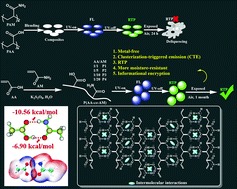Boosting the humidity resistance of nonconventional luminogens with room temperature phosphorescence via enhancing the strength of hydrogen bonds†
Abstract
Organic room temperature phosphorescence (RTP) has drawn great attention owing to its promising applications in various fields. Hydrogen bond (H-bond) engineering has been proven to be a highly effective strategy to construct nonconventional luminescent materials. However, previous reports mainly emphasize on the enhancement of rigidity via H-bond engineering, and the underlying mechanism remains unclear. Additionally, the investigation on moisture-resistance properties, which play a crucial role in preventing luminescent materials from the humidity induced quenching of RTP emission, remains lag far behind. Herein, we demonstrate a strategy for achieving nonconventional luminogens with excellent moisture resistance. Theoretical calculation was carried out to elucidate the H-bond energy between different H-bond active sites. Then, amide and carboxyl groups are selected as models to achieve RTP. The blends and random copolymers containing acrylic acid and acrylamide units with a high phosphorescent quantum efficiency (12.00%) and a decent lifetime are prepared; the afterglow can maintain for 1 month (26 °C, humidity: 80%). Benefiting from the targeting properties, the product is successfully applied for information encryption devices. It is believed that intermolecular H-bond-enhanced RTP emission with excellent humidity resistance will be extremely instructive for the further development of nonconventional luminogens.



 Please wait while we load your content...
Please wait while we load your content...